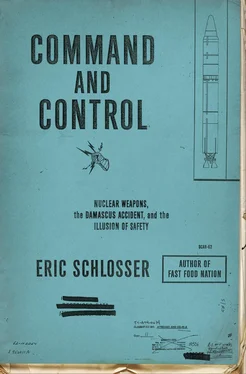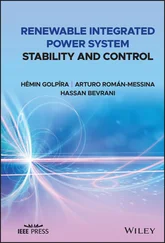Mazzaro, Childers, Holder, Fuller, and Serrano tossed their bags into the back of an Air Force blue Chevy Suburban, climbed into it, and began the hour-long drive to Damascus. Within a mile, the Suburban’s alternator light came on. So they had to turn around, go back to the base, find a new vehicle, move their gear, and fill out paperwork before leaving again. The day was not getting off to a smooth start.
The eighteen Titan II missile complexes in Arkansas were scattered throughout an area extending about sixty miles north of Little Rock Air Force Base and about thirty miles to the east and the west. The missiles were dispersed roughly seven to ten miles from each other, so that in the event of a surprise attack, one Soviet warhead couldn’t destroy more than one Titan II silo. In the American West, ICBMs were usually set amid a vast, empty landscape, far from populated areas. In central Arkansas, the Titan II complexes were buried off backcountry roads, near small farms and little towns with names like Velvet Ridge, Mountain Home, Wonderview, and Old Texas. It was an unlikely setting for some of the most powerful nuclear weapons in the American arsenal. The decision to put ICBMs in rural Arkansas had been influenced by political, as well as military, considerations. One of the state’s congressmen, Wilbur D. Mills, happened to be chairman of the House Ways and Means Committee when Titan II sites were being chosen.
To reach Launch Complex 374-7, the crew drove west through the towns of Hamlet and Vilonia, then north on Highway 65, a two-lane road that climbed into the foothills of the Ozark Mountains. Slavery had never reached this part of Arkansas, and the people who lived there were overwhelmingly poor, white, hardworking, and self-sufficient. It was the kind of poverty that carried little shame, because everyone seemed to be in the same boat. The local farms were usually thirty to forty acres in size and owned by the same families for generations. Farmers ran cattle, owned a few pigs, grew vegetables in the backyard. They were patriotic and rarely complained about the missiles in the neighborhood. Most of the income generated by the 308th was spent in the area around Little Rock. Aside from the occasional purchase of coffee and doughnuts, the missile crews passing through these rural communities added little to the local economy. For the most part, the airmen were treated warmly or hardly noticed. Despite the poverty, the feel of the place was bucolic. In early fall the fields were deep green, dotted with round bales of hay, and the leaves on the trees — the black gums, sweet gums, maples, and oaks — were beginning to turn.
The population of Damascus was about four hundred. The town consisted of a gas station, a small grocery store, and not much else. A few miles north along Highway 65, right after an old white farmhouse with a rusted tin roof, the combat crew turned left onto a narrow paved road, crossed a cattle guard, and drove half a mile. The launch complex was hidden from view until the road reached the crest of a low hill, and then there it was: a flat, square, three-acre patch of land covered in gravel and ringed in chain link, with the massive silo door in the middle, a couple of paved, rectangular parking areas on either side of it, half a dozen antennae rising from the ground, and a tall wooden pole that had three status lights mounted on top of it, one green, one yellow, one red, and a Klaxon. The green said that all was clear, the yellow warned of a potential hazard, and the red light meant trouble. It rotated like the red lights on an old-fashioned highway patrol car and, accompanied by the loud blare of the Klaxon, warned that there was an emergency on the site — or that the missile was about to take off.
The launch complex didn’t look like a high-security, military outpost. The gray concrete silo door could have passed, to the untrained eye, as the cover of a municipal wastewater treatment plant. The sign on the entry gate spelled it out. “WARNING,” it said, in red capital letters, followed by these words in capital blue: “U.S. AIR FORCE INSTALLATION, IT IS UNLAWFUL TO ENTER THIS AREA WITHOUT PERMISSION OF THE INSTALLATION COMMANDER.” The barbed wire atop the chain-link fence discouraged a casual stroll onto the property, as did the triangular AN/TPS-39 radar units. Mounted on short metal poles and nicknamed “tipsies,” they detected the slightest motion near the silo door or the air intake shaft and set off an alarm.

Diagram by Gideon Kendall
Captain Mazzaro got out of the truck, picked up the phone at the gate, and notified the control center of their arrival. The gate was unlocked by the crew underground, and Mazzaro walked across the complex to the access portal, a sixteen-foot-square slab of concrete raised about a foot off the ground. Two steel doors lay flat on the slab; beneath one was an elevator, below the other a stairway. Mazzaro opened the door on the left, climbed down a flight of concrete stairs, and waited a moment to be buzzed through another steel door. After he passed through it, the door locked behind him. Mazzaro had entered the entrapment area, a metal stairway enclosed on one side by a wall and on the other by steel mesh that rose to the ceiling. It looked like he’d walked into a cage.
At the bottom of the stairs was another locked door, with a television camera above it. Mazzaro picked up the phone on the wall, called the control center again, pulled a code card from his pocket, and read the six-letter code aloud. After being granted permission to enter, he took out some matches and set the code card on fire. Then he dropped the burning card into a red canister mounted on the steel mesh. The rest of the crew was allowed to enter the complex. They parked the Suburban, checked the site for any signs of weather damage or a propellant leak, headed down the access portal, waited a moment in the entrapment area, then were buzzed through the door at the bottom of the stairs.
The crew descended two more flights and reached an enormous blast door at the bottom of the stairs, about thirty feet underground. The access portal and its metal stairway were not designed to survive a nuclear blast. Everything beyond this blast door was. The steel door was about seven feet tall, five feet wide, and one foot thick. It weighed roughly six thousand pounds. The pair of steel doorjambs that kept it in place weighed an additional thirty-one thousand pounds. The blast door was operated hydraulically, with an electric switch. When the door was locked, four large steel pins extended from it into the frame, creating a formidable, airtight seal. When the door was unlocked, it could easily be swung open or shut by hand. The launch complex had four identical blast doors. For some reason this first one, at the bottom of the access portal, was blast door 6.
Mazzaro picked up a phone near the door and called the control center again. He pushed a button on the wall, someone in the control center pushed a button simultaneously, and the pins in the door retracted from the frame. The crew opened the huge door and stepped into the blast lock, a room about eleven feet long and twelve feet wide. It was a transitional space between the access portal and the rest of the underground complex. Blast door 6 was at one end, blast door 7 at the other. In order to protect the missile and the control center from an explosion, the doors had been wired so that both couldn’t be open at the same time. Beyond blast door 7 was another blast lock, “the junction.” To the right of it, a long steel-lined tunnel, “the cableway,” led to the missile. To the left, a shorter tunnel led to the control center. These two corridors were blocked by opposing blast doors, numbers 8 and 9, that also couldn’t be opened at the same time.
Читать дальше













